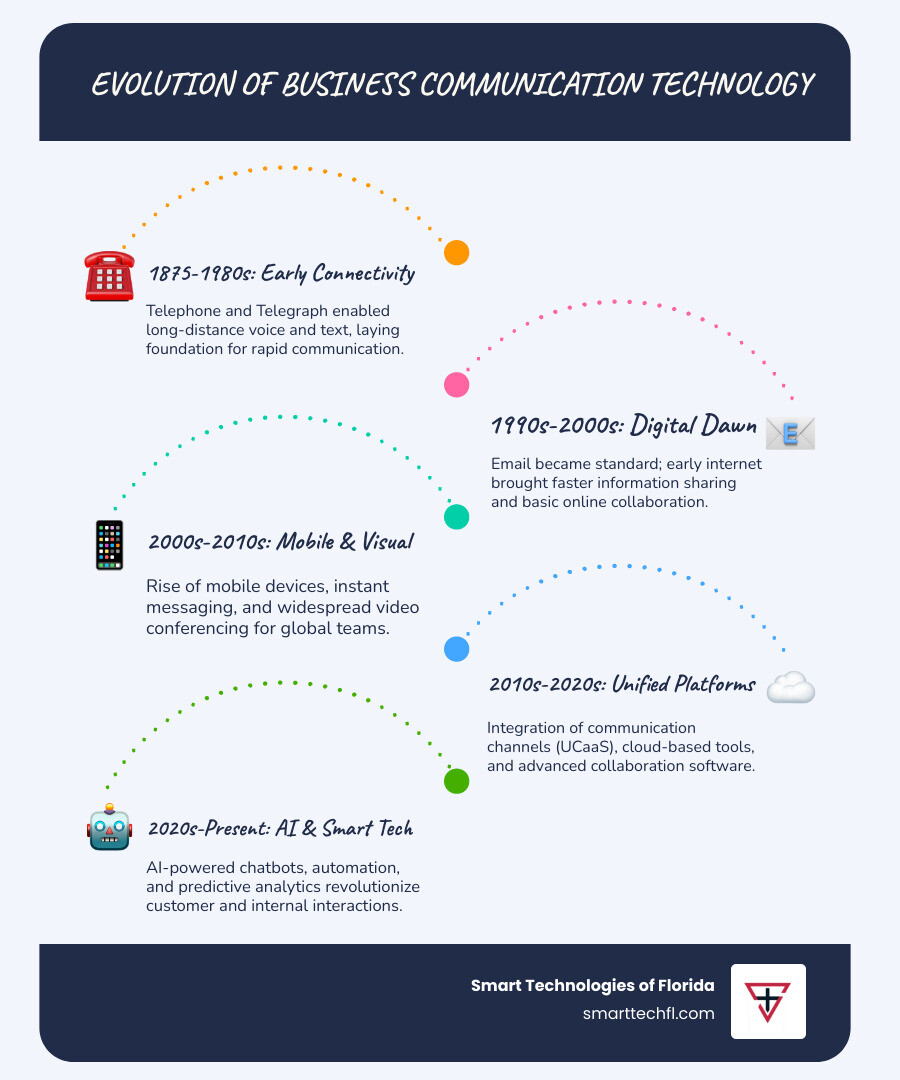Why Your Business Communication Needs a Tech Upgrade (Yesterday!)
Technology and business communication have become inseparable in today’s workplace. What started with handwritten memos and face-to-face meetings has transformed into a digital ecosystem of instant messaging, video conferencing, and AI-powered tools that connect teams across the globe in real-time.
Key aspects of technology in business communication:
- Speed: Messages travel instantly across any distance
- Accessibility: Teams can connect from anywhere, anytime
- Collaboration: Real-time document sharing and project management
- Cost-effectiveness: Reduced travel and operational expenses
- Global reach: Breaking down geographical barriers
- Data insights: Analytics to improve communication strategies
The numbers tell the story of this dramatic shift. According to The Economist, Americans went from spending just 5% of their time working from home before the pandemic to a staggering 60% by mid-2020. Meanwhile, a Mio survey found that 91% of businesses now use two or more workplace communication platforms for messaging.
This isn’t just about convenience – it’s about survival. Employee disengagement costs the global economy trillions of dollars annually, according to Gallup research. Companies that fail to modernize their communication tools risk falling behind competitors who accept digital change.
Yet this evolution brings both opportunities and challenges. While technology enables unprecedented collaboration and efficiency, it also introduces new complexities like information overload, cybersecurity risks, and the potential loss of human connection in our increasingly digital workplace.

The Unmissable Advantages of Technology in Business Communication
Remember when getting a message to someone meant playing phone tag for days or waiting for the mail? Those days feel like ancient history now. Technology and business communication have joined forces to create something truly remarkable – a world where distance doesn’t matter, responses happen in seconds, and your team can work together even when they’re scattered across different time zones.

The most obvious game-changer is speed. Your message reaches someone in Tokyo just as fast as it reaches someone in the next office. This isn’t just convenient – it’s changeal. Decisions that used to take weeks now happen in hours. Problems get solved before they become disasters. Opportunities don’t slip away while you’re waiting for someone to return your call.
This lightning-fast communication naturally leads to improved collaboration. When your team can share files, edit documents together, and brainstorm in real-time, something magical happens. Ideas flow more freely. Projects move faster. Everyone stays in the loop, whether they’re working from home in pajamas or sitting in a coffee shop halfway around the world.
Let’s talk about everyone’s favorite topic: cost savings. Digital communication tools can slash your expenses in ways that might surprise you. No more flying across the country for a two-hour meeting. No more hefty phone bills for international calls. Many companies have even reduced their office space needs, thanks to remote work becoming not just possible, but incredibly productive. As The Rise Of Working From Home shows, this shift has fundamentally changed how we think about workplace productivity.
The global reach that technology provides is nothing short of amazing. Your small business in Florida can now easily communicate with suppliers in Asia, clients in Europe, and remote workers anywhere there’s an internet connection. The world really has become your marketplace, and technology is the bridge that makes it all possible.
There’s also the often-overlooked benefit of improved data management. Digital communication tools automatically create records of conversations, decisions, and project updates. This means you can easily track what was decided when, onboard new team members faster, and ensure nothing falls through the cracks. For businesses looking to optimize these advantages, our Communication Solutions Guide for Businesses offers practical strategies for implementation.
Boosting Efficiency and Productivity
Here’s where technology and business communication really shine – making everyone more productive without working harder. It’s like having a superpower that multiplies your team’s effectiveness.
Real-time communication through instant messaging and video calls means problems get solved immediately. No more waiting days for email responses or struggling to coordinate schedules for meetings. When someone has a question, they get an answer. When a decision needs to be made, it happens.
But here’s something interesting: not all communication needs to happen instantly. Understanding asynchronous vs synchronous communication can actually boost your productivity. Synchronous communication – like video calls or phone conversations – happens in real-time and is perfect for brainstorming or urgent decisions. Asynchronous communication – like emails or project comments – lets people respond when they’re focused and ready, leading to more thoughtful responses.
Modern project management systems take this efficiency to the next level by creating streamlined workflows. Everything your team needs – tasks, deadlines, files, and conversations – lives in one place. No more hunting through email chains or wondering which version of a document is the latest. This integration is key to Streamlining Business Operations and creating a workplace that actually works for everyone.
The beauty of reduced travel can’t be overstated. While face-to-face meetings still have their place, technology lets you accomplish most business communication without leaving your office. This saves time, money, and energy while often leading to more focused, productive conversations.
Expanding Reach and Improving Customer Service
Technology doesn’t just help your team communicate better – it transforms how you connect with customers too. And honestly, your customers have come to expect this level of service.
The ability to offer 24/7 availability used to be a luxury only large corporations could afford. Now, even small businesses can provide round-the-clock support through smart use of technology. Your customers can get help when they need it, not just when you’re in the office.
Chatbots have evolved from those frustrating automated phone systems to genuinely helpful digital assistants. Today’s chatbots can handle routine questions, help customers find what they’re looking for, and even complete simple transactions. They’re like having a tireless customer service representative who never needs a coffee break.
AI-powered support takes this even further by learning from each interaction. These systems can predict what customers need, offer personalized recommendations, and route complex issues to the right human expert. The result is faster response times and customers who feel understood and valued.
Personalized communication has become the gold standard for customer service. Technology lets you remember customer preferences, track their history with your company, and tailor your messages to their specific needs. It’s like having a conversation with someone who really knows you – and customers love that feeling.
For businesses ready to upgrade their communication capabilities, exploring VoIP Business Solutions can provide the foundation for all these customer service improvements while reducing costs and increasing reliability.
While technology and business communication offer incredible benefits, they also bring a whole new set of challenges that can catch even the most tech-savvy businesses off guard. Think of it like upgrading from a bicycle to a sports car – you get amazing speed and power, but you also need to learn how to handle the complexity that comes with it.

The biggest challenge many businesses face today is information overload. Picture this: you’re trying to focus on an important project, but your phone keeps buzzing with Slack messages, your email inbox shows 47 unread messages, and three different video calls are scheduled back-to-back. Sound familiar?
As researcher Alvin Toffler explained, information overload happens “when the amount of input to a system exceeds its processing capacity… and it is likely that a reduction in decision quality will occur.” In plain English, when we’re drowning in too much information, we actually make worse decisions and feel more stressed.
Cybersecurity threats and data privacy concerns add another layer of complexity. Every digital message, shared document, and video call creates potential entry points for hackers. Technical glitches seem to have a talent for happening at the worst possible moments – like when you’re presenting to your biggest client and the video call freezes.
The digital divide creates another hurdle. Not everyone on your team may be equally comfortable with new technologies, and this can create frustration and inequality. Some employees might feel left behind, leading to employee disengagement when they struggle to keep up with constantly evolving digital tools.
For businesses looking to protect themselves from these growing threats, our Cybersecurity Solutions for Small Business provide comprehensive protection custom to your specific needs.
The Risk of Misinterpretation and Weaker Relationships
Here’s something that might surprise you: we lose about 93% of our communication effectiveness when we move from face-to-face conversations to text-based messages. That’s because we’re missing all those non-verbal cues – the raised eyebrow, the smile, the tone of voice that tells us someone is joking rather than being sarcastic.
Without these visual and vocal signals, misinterpretation becomes surprisingly common. That email you thought sounded friendly? Your colleague might have read it as demanding or cold. A quick “Fine” in response to a request could be interpreted as passive-aggressive when it was meant to be simply agreeable.
This challenge goes deeper than just misunderstood messages. When teams rely heavily on digital communication, personal connections can weaken over time. Those spontaneous hallway conversations, shared coffee breaks, and casual check-ins that build trust and camaraderie get lost in the digital shuffle.
Digital fatigue is real, and it’s exhausting. After spending eight hours on video calls, many employees feel more drained than they would after a full day of in-person meetings. The constant screen time, combined with the extra mental energy needed to interpret digital communication, takes its toll.
Maintaining company culture becomes particularly challenging when teams are scattered across different locations and time zones. The shared experiences, inside jokes, and team spirit that develop naturally in physical offices require deliberate effort to recreate in digital spaces. You can learn more about this critical aspect at The importance of nonverbal communication.
Security and Privacy in the Digital Age
If you think cybersecurity is just an IT problem, think again. In today’s interconnected business world, every employee becomes a potential gateway for both security and vulnerability. The convenience of technology and business communication comes with serious responsibilities.
Data breaches have become increasingly sophisticated and costly. When sensitive business information, customer data, and private communications are stored digitally, they become attractive targets for cybercriminals. The average cost of a data breach now exceeds $4 million, and that’s just the direct costs – not including the damage to reputation and customer trust.
Phishing attacks have evolved far beyond those obviously fake emails from Nigerian princes. Modern phishing attempts can look exactly like legitimate messages from trusted partners, banks, or even internal team members. These attacks trick employees into revealing passwords, downloading malware, or providing access to secure systems.
Malware threats continue to evolve, with new variants appearing daily. These malicious programs can steal data, encrypt files for ransom, or provide backdoor access to your entire network. The importance of firewalls cannot be overstated – they serve as your first line of defense against these digital threats.
Compliance requirements like GDPR add another layer of complexity. Businesses must carefully track how customer data is collected, stored, and used across all their communication platforms. Violations can result in hefty fines and legal complications.
Protecting your business requires a comprehensive approach that includes employee training, robust security software, and secure communication platforms. Understanding antivirus software is essential, but it’s just one piece of the puzzle.
For businesses serious about protecting their communications, our Secure Email Software provides enterprise-level security that’s simple enough for any team to use effectively.
The Core Technologies Changing How We Work and Connect
The digital revolution has brought forth a dazzling array of tools that have fundamentally reshaped how we conduct business. These aren’t just gadgets; they are the very infrastructure of modern technology and business communication, allowing us to work smarter, not harder.

At the foundation, we have staples like email, which has evolved from a simple messaging tool to a sophisticated workflow management system. Then there’s instant messaging (think Slack or Microsoft Teams), which facilitates quick discussions and real-time collaboration. Video conferencing platforms (Zoom, Google Meet) have become indispensable, especially for remote and hybrid teams, allowing for face-to-face interactions across geographical distances.
Beyond these common tools, businesses leverage cloud computing for scalable storage and shared document collaboration, mobile technology for on-the-go connectivity, and sophisticated project management systems to keep complex initiatives organized. We also see the rise of VoIP (Voice over Internet Protocol) for flexible phone systems, and of course, the ever-growing influence of AI and automation. For a comprehensive overview, our Business Communication Tools Guide lists many essential communication tools for modern businesses.
Unified Communications (UCaaS) and Collaboration Platforms
Imagine a world where all your communication tools live in one happy place. That’s the promise of Unified Communications as a Service (UCaaS) and modern collaboration platforms. These systems act as centralized communication hubs, integrating various tools into a single, seamless experience.
With UCaaS, you get instant messaging for quick chats, video conferencing for virtual meetings, and file sharing capabilities, all within the same ecosystem. This means less toggling between apps and more focus on the work itself. Many platforms also offer project management integration, allowing teams to centralize tasks, deadlines, and documents, fostering real-time collaboration and a shared information environment. This kind of integration is key to opening up Unified Communications in Business Success.
The Impact of AI and Automation on Technology and Business Communication
If technology is the engine of modern business communication, then AI and automation are the turbochargers. They’re not just making things faster; they’re making them smarter.
AI-powered chatbots are revolutionizing customer service, handling basic queries 24/7, freeing up human agents, and providing instant, accurate responses. Beyond customer-facing roles, AI can power automated email responses, manage schedules, and even draft initial communications, saving countless hours.
But AI’s impact goes deeper. Sentiment analysis tools, for example, can analyze text or speech to gauge customer or employee sentiment, providing valuable real-time insights into satisfaction and engagement. Predictive analytics, driven by AI, can analyze large volumes of data to identify patterns and trends, helping businesses anticipate customer needs or market shifts. This allows for hyper-personalized communication and more effective marketing strategies. The power of these tools truly shines in Business Process Automation.
Cloud and Mobile Technologies: Communication Without Borders
The ability to communicate from virtually anywhere has fundamentally reshaped the modern workplace, and we owe a huge debt of gratitude to cloud and mobile technologies. They’ve truly made technology and business communication borderless.
Cloud-based phone systems and VoIP have replaced traditional landlines, offering features like call forwarding, multi-user conferencing, and voicemail-to-email, all accessible via the internet. This means your business phone system is no longer tied to a physical location.
Couple this with the ubiquity of mobile apps on smartphones and tablets, and you have true access from anywhere. Employees can respond to emails, join video calls, and collaborate on documents whether they’re at their desk, working remotely from home in Daytona Beach, FL, or traveling halfway across the globe. This mobility fosters tremendous scalability for businesses, allowing them to expand their workforce and operations without being constrained by physical infrastructure. It’s a key component of modern Cloud Communication Solutions.
Building a Future-Proof Communication Strategy
Adopting cutting-edge technology and business communication tools is one thing; making them work effectively for your organization is another. It requires a thoughtful, strategic approach – not just buying the latest shiny object.

This is where IT Consulting Services become invaluable. A robust communication strategy involves careful change management to ensure employees accept new tools, not resist them. It also means comprehensive employee training programs that teach not just how to use the software, but how to use it effectively for business goals. Finally, establishing clear communication policies is crucial to set expectations for response times, appropriate channels for different types of messages, and digital etiquette. This creates a predictable and productive communication environment for everyone.
How to Effectively Implement Technology and Business Communication Tools
So, you’re ready to upgrade your communication game? Fantastic! But don’t just dive in headfirst. Effective implementation is key to maximizing the benefits of technology and business communication.
First, start by assessing your needs. What are your current communication pain points? Where are the bottlenecks? Understanding your unique challenges will help you choose the right tools that truly address your organization’s specific requirements. 91% of businesses use two or more platforms, so pick what truly works for you, not just what’s popular.
Next, consider a phased implementation. Rolling out new technology gradually allows your team to adapt and provides opportunities to iron out kinks along the way. Comprehensive staff training is non-negotiable. Don’t just show them how to click buttons; teach them the “why” behind the tools and how to integrate them into their daily workflows.
Finally, setting clear guidelines for communication is vital. When should you use email versus a chat app? What are the expected response times? Are emojis allowed in formal communications? Establishing these rules prevents information overload and ensures consistency. And while it can be tricky, try to measure ROI on your communication technology investments to ensure they are truly delivering value.
Balancing Tech Efficiency with the Human Touch
This is perhaps the biggest tightrope walk in modern technology and business communication: how do we accept efficiency without losing our humanity? It’s a delicate balance, but one we must master.
While AI and automation can streamline tasks, they can’t replace the nuanced understanding of a human conversation. The goal isn’t to eliminate human interaction but to improve it. We need to actively work on fostering authentic connections in a digital world. This means being intentional about when to use different communication modalities.
For instance, quick updates and routine information are perfect for email or chat. But for complex problem-solving, sensitive discussions, or relationship-building, a video call offers visual cues and a sense of presence. And for truly critical decisions or team bonding, there’s still immense value in in-person meetings.
It’s about preserving emotional intelligence and building trust. An AI might generate the most statistically likely response, but it won’t understand sarcasm, offer genuine empathy, or build rapport like a human can. Over-reliance on AI could even diminish our own communication skills. We must ensure human oversight and judgment remain paramount, especially when creating personalized communications. For more on this critical balance, explore How to balance automation and human interaction.
The Future is Now: Emerging Trends in Business Communication
The world of technology and business communication never stands still, and honestly, that’s what makes it so exciting! We’re witnessing incredible innovations that will transform how we connect, collaborate, and conduct business in ways we’re only beginning to imagine.

Picture this: instead of staring at yet another video call grid, you’re sitting around a virtual conference table with colleagues from around the world, manipulating 3D product models together and sketching ideas on floating whiteboards. That’s the promise of the Metaverse and immersive collaboration. While it might sound like science fiction, businesses are already experimenting with virtual reality meeting spaces that create a genuine sense of presence and shared experience.
The backbone supporting these futuristic interactions is 5G connectivity. This isn’t just about faster internet – it’s about removing the technical barriers that make current digital communication frustrating. With 5G’s lightning-fast speeds and minimal delays, high-quality video calls will become as reliable as turning on a light switch, and those VR meetings won’t leave you feeling dizzy from lag.
Meanwhile, the Internet of Things (IoT) is quietly making our workspaces smarter. Imagine walking into a meeting room that automatically adjusts the lighting and temperature, books itself on your calendar, and even suggests the best seating arrangement based on who’s attending. These connected devices are creating communication environments that adapt to our needs rather than the other way around.
Perhaps most intriguingly, we’re moving toward hyper-personalization in business communication. Advanced AI and data analytics will soon allow every message, every notification, and every interaction to be custom specifically to how each person prefers to receive and process information. It’s like having a personal communication assistant who knows exactly how to reach you most effectively.
On the security front, blockchain for secure communication is emerging as a powerful tool. While most people associate blockchain with digital currency, its ability to create tamper-proof records makes it incredibly valuable for protecting sensitive business communications and ensuring that important messages haven’t been altered in transit.
These innovations represent more than just cool technology – they’re reshaping the fundamental nature of how we work together. As outlined in The future of digital change, these advances are building global resilience and creating new possibilities for collaboration that we’re only beginning to explore.
Conclusion: Your Next Step in Business Communication Excellence
We’ve taken quite a journey together, haven’t we? From the days of handwritten memos to AI-powered chatbots that never sleep, technology and business communication have become the beating heart of modern business success.
Here’s what we’ve learned: technology is an incredible enabler. It breaks down walls, speeds up decisions, and connects us in ways our grandparents could never have imagined. But here’s the thing – just buying the fanciest communication tools won’t magically solve all your problems. It’s like buying a Ferrari and not knowing how to drive stick shift.
That’s why strategy is crucial. You need a thoughtful plan that considers your team’s unique needs, addresses potential pitfalls like information overload and cybersecurity threats, and actually aligns with what your business is trying to achieve. Without strategy, even the best technology can become an expensive headache.
But perhaps most importantly, human connection remains paramount. No matter how sophisticated our tools become, business is still fundamentally about people connecting with people. The most successful organizations are those that use technology to improve human relationships, not replace them.
Think about it – would you rather receive a perfectly crafted AI-generated email that feels cold, or a slightly imperfect message from a colleague who clearly cares about helping you succeed? The answer is obvious, right?
At Smart Technologies of Florida, we get it. We’ve been helping businesses like yours steer this exciting but sometimes overwhelming landscape for 23 years. Our people-centric approach means we don’t just throw technology at problems – we take the time to understand your unique challenges and goals.
Whether you’re a small business in Daytona Beach, FL, looking to modernize your communication systems, or a growing company ready to accept the future of digital collaboration, we’re here to guide you every step of the way. Because at the end of the day, successful technology and business communication isn’t about having the most gadgets – it’s about empowering your people to do their best work.
Ready to take that next step toward communication excellence? Explore our Business Communication Solutions and let’s start building something amazing together!












